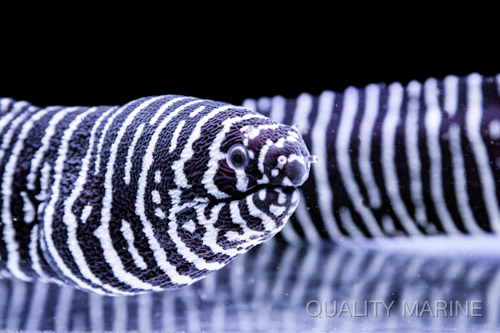Morays In The Reef Tank?

The phrase "reef-safe" can mean many different things depending on which reef aquarium hobbyist you happen to ask at that very moment. For the most part, we can all say that we would not want fish that snack on sessile invertebrates in particular cnidarians like your coral. Many risk takers in the industry and hobby will shape the plan for their reef around certain fish. Such as avoiding Tridacnids or an LPS Corals for a large angel such as a Holocanthus sp. Then there are large carnivores that may attack motile invertebrates, specifically crustaceans as well as small fish but have no interest in your coral. Both the former and the latter fall into another hobbyist created term, "reef safe, with caution." One of the groups that fits this bill are the menacing looking moray eels, which can make stunning displays in a reef-type set up where the contrast of their colors against the back drop of live coral really have a chance to stand out. Regarding Muraenidae, while many have rightfully earned their place in species only biotopes or large predator tanks. There are however a select amount of individuals who have earned themselves candidacy for mixed reef aquaria for being generally fish safe.
Foremost it's essential to note that an eels size alone is not necessarily an observation that should factor into the decision-making process when regarding those that eat small fish. Many species labeled as "dwarf" are adept fish hunters. A great indicator is reflecting on the wild diet of your prospective eel. To get an idea we can look at the dental record of a certain genus of morays. Some possess teeth that appear to the untrained eye look more like human molars than the K-9 looking fangs we most often associate them. These are called the pebble toothed eels, feeding mostly on crustaceans or invertebrates with hard shells. These teeth are designed for crushing the exoskeleton of prey while the phargeaneal jaw holds it in place. For those unfamiliar with what a pharyngeal jaw is, it looks quite like something from an H. R. Giger art piece or a Ridley Scott Alien movie. Wherein a secondary set of jaws are contained within the throat, completely separate from the primary tooth set. To be succinct morays means quite literally to have two sets of jaws, each with their own set of teeth. Of those genus of interest to reef aquarists, the most likely are Gymnomuraena, Siderea, Echidna which have the more dulled teeth as aforementioned. These genus also haven't developed adept eyesight, they are more likely to rummage about the reef using a highly refined sense of smell to track prey quite literally bumping into them before striking. While not a guarantee, these behaviors, and evolutionary adaptations make them less prone to attacking healthy fish unlike their family members in the Gymnothrax genus.
The most common eel in the industry is also conveniently one of the safest bets for the mixed reef tank, the Snowflake Eel (Echidna nebulosa). It fits into the pebble toothed complex, and its diet primarily consists of intertidal crustaceans, such as spider crabs. They also stay at a very manageable size for a moray. While they can grow to nearly 40" (~102cm) these are extreme cases and most captive specimens will not exceed 24" (~61cm) with the largest just pushing 30"(~76cm). They also are one of the most personable eels, quickly adjusting to captive life and not being as shy as some of their co-genitors or other moray family members. They readily accept a multitude of frozen marine meaty food.

Another great common choice is the Zebra Moray Eel (Gymnomuraena zebra), another tropical reef dweller. They are initially much more reclusive than the above mentioned Snowflake Eel as they do most of their hunting within the reef structure itself, rather than having their head continuously protruding from the rock work. This is an extremely docile eel, do not be surprised or alarmed if they spend a few weeks hiding, even going on a hunger strike. They are more muscular than the Snowflake and perhaps even have worse eyesight, finding it necessary to bump into prey to identify them at times. While they may not directly consume sessile inverts, they can potentially doom them by knocking them down from their perches. Make sure they are tied or glued/epoxyed down sufficiently. Ornamental crustaceans are however possibly on the menu, so keep them well fed an introduce any crustaceans before the eel. While Zebras Morays reach a potential 60" in length (~150cm) they are more commonly observed at 24" (~61cm). Keep in mind that while pebbled tooth morays are docile, their lack of adequate eyesight makes them clumsy when feeding. For your safety we advise using a feeding stick.
To summarize; pebbled tooth morays are generally fish safe, while fanged eels, by and large are fish eaters. While we cannot guarantee that all "Reef safe" eels are 100% compatible with your other tank denizens, as each have their own individual personalities, these two species are your best bets.